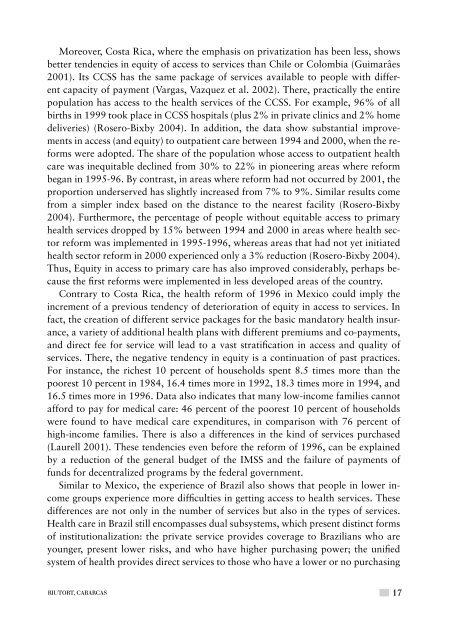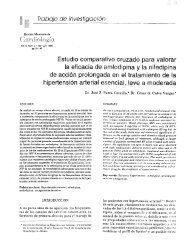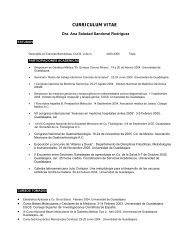Desigualdad Social y Equidad en Salud: Perspectivas Internacionales
Desigualdad Social y Equidad en Salud: Perspectivas Internacionales
Desigualdad Social y Equidad en Salud: Perspectivas Internacionales
- No tags were found...
You also want an ePaper? Increase the reach of your titles
YUMPU automatically turns print PDFs into web optimized ePapers that Google loves.
Moreover, Costa Rica, where the emphasis on privatization has be<strong>en</strong> less, showsbetter t<strong>en</strong>d<strong>en</strong>cies in equity of access to services than Chile or Colombia (Guimarâes2001). Its CCSS has the same package of services available to people with differ<strong>en</strong>tcapacity of paym<strong>en</strong>t (Vargas, Vazquez et al. 2002). There, practically the <strong>en</strong>tirepopulation has access to the health services of the CCSS. For example, 96% of allbirths in 1999 took place in CCSS hospitals (plus 2% in private clinics and 2% homedeliveries) (Rosero-Bixby 2004). In addition, the data show substantial improvem<strong>en</strong>tsin access (and equity) to outpati<strong>en</strong>t care betwe<strong>en</strong> 1994 and 2000, wh<strong>en</strong> the reformswere adopted. The share of the population whose access to outpati<strong>en</strong>t healthcare was inequitable declined from 30% to 22% in pioneering areas where reformbegan in 1995-96. By contrast, in areas where reform had not occurred by 2001, theproportion underserved has slightly increased from 7% to 9%. Similar results comefrom a simpler index based on the distance to the nearest facility (Rosero-Bixby2004). Furthermore, the perc<strong>en</strong>tage of people without equitable access to primaryhealth services dropped by 15% betwe<strong>en</strong> 1994 and 2000 in areas where health sectorreform was implem<strong>en</strong>ted in 1995-1996, whereas areas that had not yet initiatedhealth sector reform in 2000 experi<strong>en</strong>ced only a 3% reduction (Rosero-Bixby 2004).Thus, Equity in access to primary care has also improved considerably, perhaps becausethe first reforms were implem<strong>en</strong>ted in less developed areas of the country.Contrary to Costa Rica, the health reform of 1996 in Mexico could imply theincrem<strong>en</strong>t of a previous t<strong>en</strong>d<strong>en</strong>cy of deterioration of equity in access to services. Infact, the creation of differ<strong>en</strong>t service packages for the basic mandatory health insurance,a variety of additional health plans with differ<strong>en</strong>t premiums and co-paym<strong>en</strong>ts,and direct fee for service will lead to a vast stratification in access and quality ofservices. There, the negative t<strong>en</strong>d<strong>en</strong>cy in equity is a continuation of past practices.For instance, the richest 10 perc<strong>en</strong>t of households sp<strong>en</strong>t 8.5 times more than thepoorest 10 perc<strong>en</strong>t in 1984, 16.4 times more in 1992, 18.3 times more in 1994, and16.5 times more in 1996. Data also indicates that many low-income families cannotafford to pay for medical care: 46 perc<strong>en</strong>t of the poorest 10 perc<strong>en</strong>t of householdswere found to have medical care exp<strong>en</strong>ditures, in comparison with 76 perc<strong>en</strong>t ofhigh-income families. There is also a differ<strong>en</strong>ces in the kind of services purchased(Laurell 2001). These t<strong>en</strong>d<strong>en</strong>cies ev<strong>en</strong> before the reform of 1996, can be explainedby a reduction of the g<strong>en</strong>eral budget of the IMSS and the failure of paym<strong>en</strong>ts offunds for dec<strong>en</strong>tralized programs by the federal governm<strong>en</strong>t.Similar to Mexico, the experi<strong>en</strong>ce of Brazil also shows that people in lower incomegroups experi<strong>en</strong>ce more difficulties in getting access to health services. Thesediffer<strong>en</strong>ces are not only in the number of services but also in the types of services.Health care in Brazil still <strong>en</strong>compasses dual subsystems, which pres<strong>en</strong>t distinct formsof institutionalization: the private service provides coverage to Brazilians who areyounger, pres<strong>en</strong>t lower risks, and who have higher purchasing power; the unifiedsystem of health provides direct services to those who have a lower or no purchasingRiutort, Cabarcas17
















